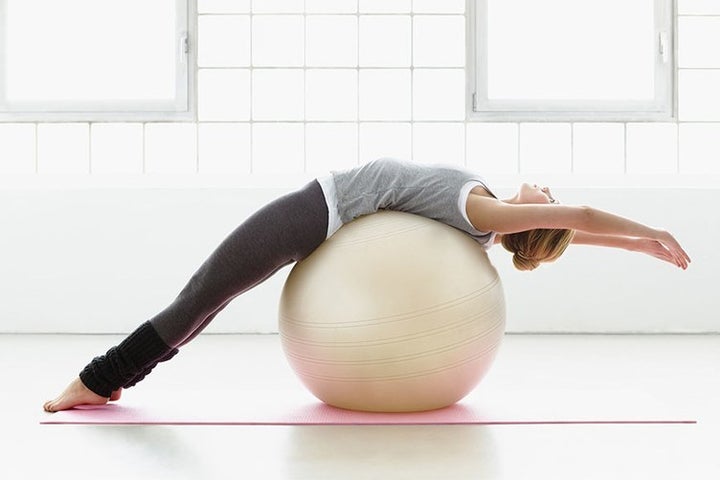For SELF, by Alexa Tucker.

Unless you work out for a living, chances are, you don’t have an endless number of hours to spend in the gym every week. (Wouldn’t it be nice?) But no matter how many days you have to work on your fitness goals, it’s tough to know how to split your time between different types of exercise.
Yeah, workout variety is a good thing, but with endless moves, classes, and online programs out there, knowing where to start is half the battle. Cardio, strength training, and rest are all major aspects of living an active lifestyle, but how much of each should you be doing?
Noam Tamir, CSCS, founder of TS Fitness, can help. If you’re looking to maintain your fitness level, your magic number of days depends on how active you already are. For example, you’ll probably see results from one day a week if you don’t already work out at all, he says. But if your body is used to six days a week, one day probably won’t cut it.
“If you’re looking to maintain your fitness level, your magic number of days depends on how active you already are.”
The breakdown varies depending on your specific goals, but in general, four to five days a week will do the trick if you’re simply aiming to improve your fitness and stay in shape. If you’re going for the full five, three days should focus on strength training, two days should focus on cardio, and two should be active rest. If you only want to work out four days a week, think about your goals: If you want to add muscle tone, cut a cardio day. If you want to improve endurance, skip a strength day. Or, switch it each week, says Tamir.
Here’s how to crush it at each one:
Strength Training

"It's to get bulky! Just kidding," says Tamir. (But really, you won't.) "The more muscle you have the higher your metabolic rate." Read: the more calories you'll burn when you're not working out. "It also strengthens joints and bones," he adds.
How Often: Three times per week.
How Long: A strength-training session should last 45-60 minutes, plus foam rolling and at least a five-minute warm-up beforehand.
How To Do It: You want to include upper and lower body moves, and you want to have a balance between pushing and pulling movements. So, for example, a pushing movement would be a chest press, and a pulling movement would be a row. You should do different moves in each of the three strength sessions, but repeat them every week. "I would stay with a program for four to six weeks and progressively increase the weight," says Tamir. "[The week before your last week], I would have a little bit of a drop-off, to give your body a little bit of a recovery, and the last week really push it hard." Don't feel like you have to go hard on the machines: strength training can also incorporate bodyweight moves (like squats), dumbbells, kettlebells, TRX suspension trainers, and more.
Bonus Tip: Strength training is also where you can improve other elements of your fitness. "Flexibility work can be incorporated in the warm-up and during the exercises to make sure you are completing the full range of the movement," says Tamir. You can work on coordination during the warm-up with non-linear movements and patterns like crawling. You can also improve balance (and engage your core!) by doing single-leg exercises.
Cardio

As important as it is to strength train, cardio has its place in a balanced workout routine, too. “Doing cardio keeps your circulatory system working optimally helping you to recover faster...[and it] keeps your endurance up,” says Tamir. “It also increases your VO2 max, which helps your body utilize oxygen.” Check, check, and check.
How Often: Two times per week.
How Long: The American College Of Sports Medicine recommends logging 150 minutes of moderate-to-intense activity per week. How you split that up will depend on what type of training you’re doing (longer, steady-state sessions vs. shorter HIIT workouts).
How To Do It: You’ve got a ton of options: Spinning, an outdoor jog, the good old elliptical machine, the list goes on. “Whether something is cardiovascular depends on where your heart rate is at and how long you’re doing it for,” says Tamir. Target heart rates are different for everyone, but Tamir suggests that a good baseline to aim for during your cardio routines is between 120 and 150 beats per minute for 45 to 60 minutes. (Learn more about target heart rates here.) “I’m a big fan of doing functional movements to keep my heart rate up,” says Tamir. For example, consider kettlebell swings: while they can also fit into strength training, they have their place in a cardio workout, too — the key is trying to do more reps within a certain time span to keep that heart rate elevated. And you can improve your agility, while getting in some cardio, with moves like ice skaters (or using an agility ladder).
Bonus Tip: Another option is interval training, which “helps you burn more calories in the same time as steady state,” says Tamir. He likes doing 20 seconds of hard work followed by 40 seconds of active recovery for 45-60 minutes. The best part? You can do this with pretty much anything. Indoor row machine, bike, treadmill, functional movements, you name it.
Rest Days

Taking a break lets your body recover and rebuild so you can get back to your workouts refreshed and ready to rock it. Of course, this isn’t a free pass to sit on the couch all day (well, not every time at least). A rest day should actually be considered active recovery, meaning you don’t have to hit the gym or break a serious sweat, but you should do something. “It’s not just about the physical recovery — it’s also the mental,” says Tamir. “Doing something that you enjoy that’s active is great for the mind ... and it assists in residual fatigue.” Plus, it keeps up your conditioning.
How Often: Two times per week.
How Long: Aim for 30-60 minutes.
How To Do It: Whether you hit up a restorative yoga class or just take a walk, active recovery shouldn’t require a ton of effort like a workout day, but it should get you moving.
Bonus Tip: Where you place these rest days is up to you — if you do your workouts Monday through Friday, feel free to take the whole weekend off, says Tamir. Or, you could break them up by doing a strength day, a cardio day, then a rest day before getting back to weight training. Although the order doesn’t really matter, Tamir recommends not working on strength two days in a row. “You want to give your body 48 hours to recover,” he says.
Of course, your perfect gym week may vary slightly based on your goals and your schedule, but it’s all about having good fitness habits.

"If you want results, you need to have a routine that you can stick with," says Tamir. "I’ve seen so many people try to fit workouts in inconsistently, and it ends up being a waste of time." So, no matter what you do and when you do it, the goal should be to rock it, rest, repeat.
More From SELF:
